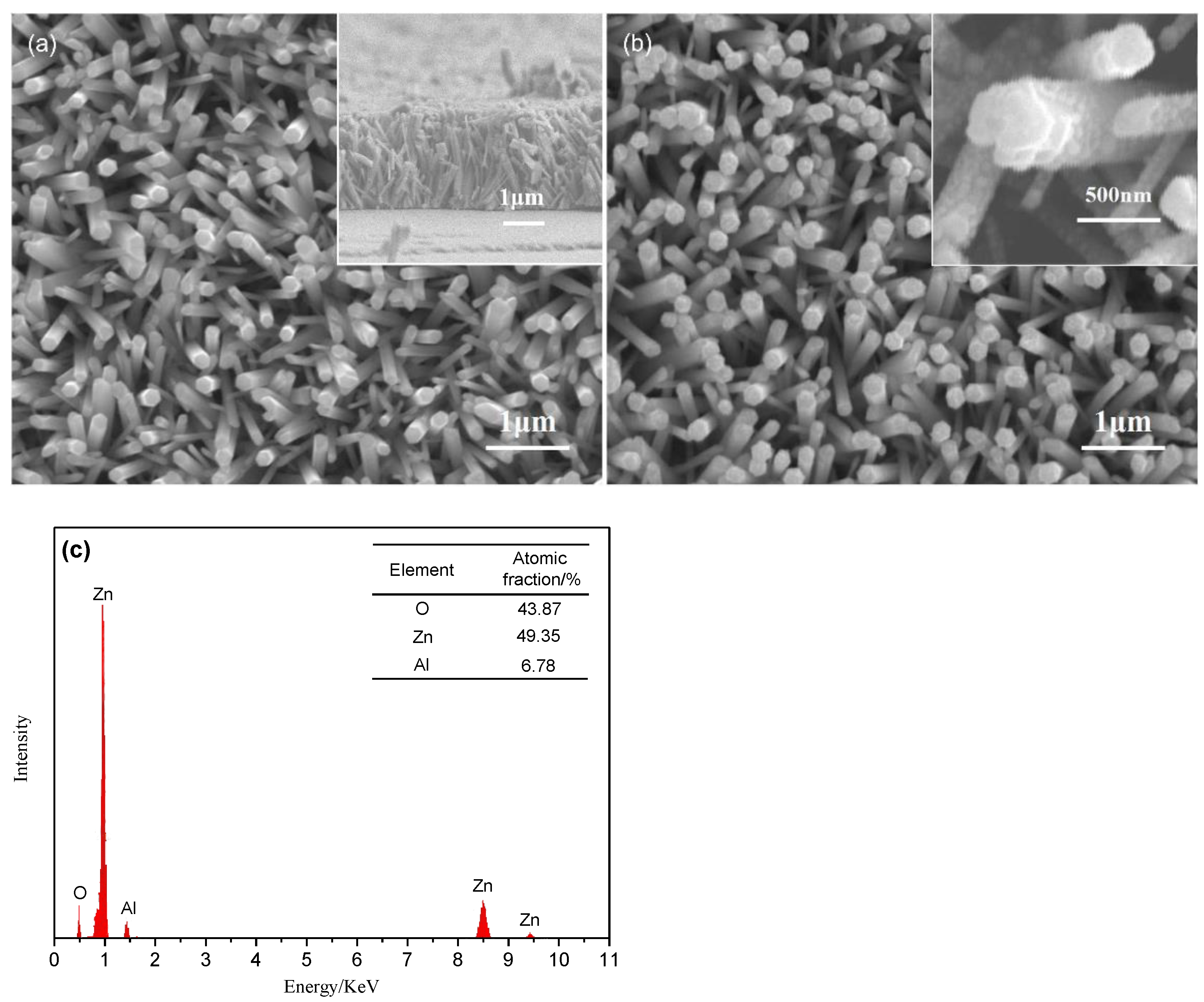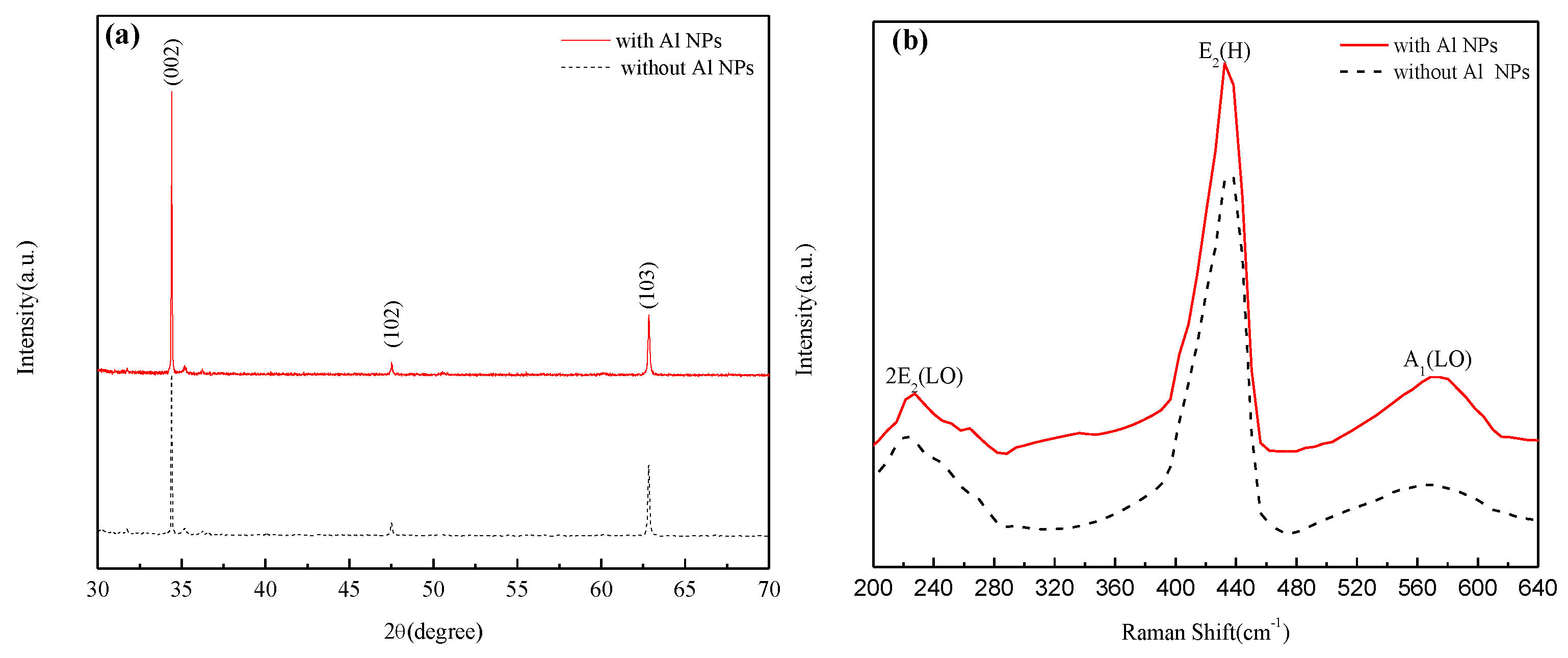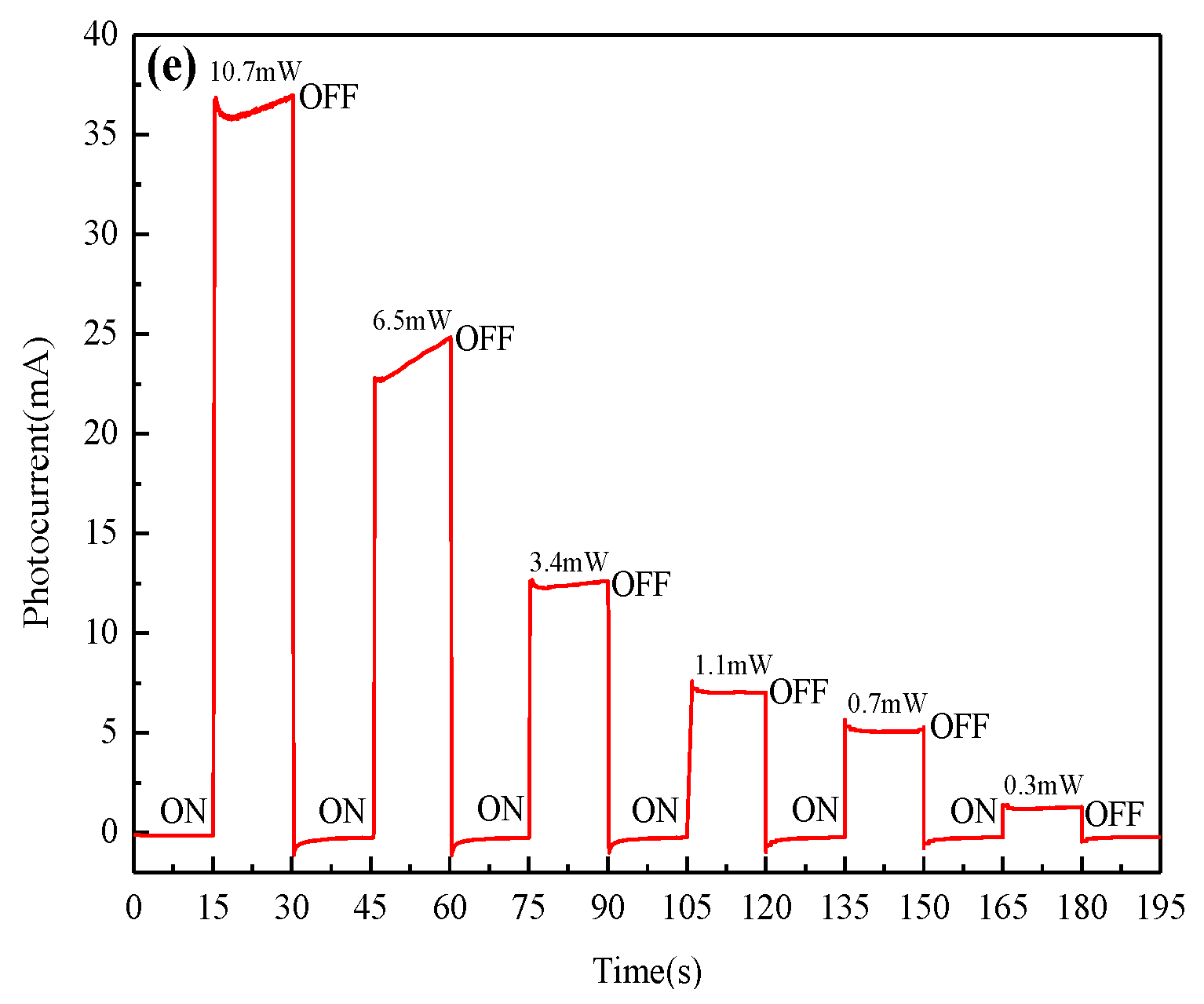Fabrication and Performance of UV Photodetector of ZnO Nanorods Decorated with Al Nanoparticles
Abstract
1. Introduction
2. Experimental Procedures
3. Results and Discussion
4. Conclusions
Author Contributions
Funding
Data Availability Statement
Acknowledgments
Conflicts of Interest
References
- Nguyen, T.T.; Patel, M.; Kim, J. Self-powered transparent photodetectors for broadband applications. Surf. Interfaces 2021, 23, 100934. [Google Scholar] [CrossRef]
- Hanna, B.; Pillai, L.R.; Rajeev, K.; Surendran, K.P.; Unni, K.N.N. Visible-blind UV photodetectors using a polymer/ZnO nanocomposite thin film. Sens. Actuator A Phys. 2022, 338, 1134951–1134959. [Google Scholar] [CrossRef]
- Choi, M.S.; Park, T.; Kim, W.J.; Hu, J. High-Performance Ultraviolet Photodetector Based on a Zinc Oxide Nanoparticle@Single-Walled Carbon Nanotube Heterojunction Hybrid Film. Nanomaterials 2020, 10, 395. [Google Scholar] [CrossRef] [PubMed]
- Hu, L.; Yan, J.; Liao, M.; Xiang, H.; Gong, X.; Zhang, L.; Fang, X. An Optimized Ultraviolet-A Light Photodetector with Wide-Range Photoresponse Based on ZnS/ZnO Biaxial Nanobelt. Adv. Mater. 2012, 24, 2305–2309. [Google Scholar] [CrossRef]
- Nallabala, N.; Godavarthi, S.; Kummara, V.K.; Kesarla, M.K.; Vattikuti, S. Structural, optical and photoresponse characteristics of metal-insulator-semiconductor (MIS) type Au/Ni/CeO2/GaN Schottky barrier ultraviolet photodetector. Mater. Sci. Semicond. Process. 2020, 117, 105190. [Google Scholar] [CrossRef]
- Peng, L.; Hu, L.; Fang, X. Low-dimensional nanostructure ultraviolet photodetectors. Adv. Mater. 2013, 25, 5321–5328. [Google Scholar] [CrossRef]
- Zhu, M.W.; Huang, N.; Gong, J.; Zhang, B.; Wang, Z.J. Growth of ZnO nanorod arrays by sol-gel method: Transition from two-dimensional film to one-dimensional nanostructure. Appl. Phys. A 2011, 103, 159–166. [Google Scholar] [CrossRef]
- Qu, Y.; Huang, X.; Li, Y.; Lin, G.; Guo, B.; Song, D.; Cheng, Q. Chemical bath deposition produced ZnO nanorod arrays as an antireflective layer in the polycrystalline Si solar cells. J. Alloy. Compd. 2017, 698, 719–724. [Google Scholar] [CrossRef]
- Bai, A.; Tang, Y.; Chen, J. Efficient photon capturing in Cu(In, Ga)Se2 thin film solar cells with ZnO nanorod arrays as an antireflective coating. Chem. Phys. Lett. 2015, 636, 134–140. [Google Scholar] [CrossRef]
- Li, C.; Yu, L.; Yuan, X.; Li, Y.; Ning, N.; Cui, L.; Ma, S.; Kang, W.; Fan, X. Ag nanorods assembled with ZnO nanowalls for near-linear highresponse UV photodetectors. J. Alloy. Compd. 2020, 830, 154652. [Google Scholar] [CrossRef]
- Chang, C.M.; Hon, M.H.; Leu, I.C. Preparation of ZnO nanorod arrays with tailored defect-related characterisitcs and their effect on the ethanol gas sensing performance. Sens. Actuators B Chem. 2010, 151, 15–20. [Google Scholar] [CrossRef]
- Zarezadeh, E.; Ghorbani, A. Bipolar photoresponse ultraviolet photodetectors based on ZnO nanowires. Mater. Res. Express 2020, 7, 056203. [Google Scholar] [CrossRef]
- Yu, X.; Yu, X.; Yan, M.; Weng, T.; Chen, L.; Zhou, Y.; Wei, J. Lowering oxygen vacancies of ZnO nanorods via Mg-doping and their effect on polymeric diode behavior. Sens. Actuator. A Phys. 2020, 312, 112163. [Google Scholar] [CrossRef]
- Chen, S.; Small, C.E.; Amb, C.M.; Subbiah, J.; Lai, T.H.; Tsang, S.W.; Manders, J.R.; Reynolds, J.R.; So, F. Inverted Polymer Solar Cells with Reduced Interface Recombination. Adv. Energy Mater. 2012, 2, 1333–1337. [Google Scholar] [CrossRef]
- Iwantono, I.; Saad, S.M.; Anggelina, F.; Awitdrus, A.; Ramli, M.A.; Umar, A.A. Enhanced charge transfer activity in Au nanoparticles decorated ZnO nanorods photoanode. Phys. E Low Dimens. Syst. Nanostruct. 2019, 111, 44–50. [Google Scholar] [CrossRef]
- Khan, R.; Uthirakumar, P.; Kim, T.H.; Lee, I.H. Enhanced photocurrent performance of partially decorated Au nanoparticles on ZnO nanorods based UV photodetector. Mater. Res. Bull. 2019, 115, 176–181. [Google Scholar] [CrossRef]
- Mohammad, S.M.; Rajamanickam, S.; Hassan, Z.; Abdullah, M.; Shafiqa, A.R.; Abuelsamen, A. Self-powered UV photodetector performance optimization based on Ag nanoparticles-encapsulated-ZnO nanorods by photo-deposition method. Sens. Actuator. A Phys. 2021, 331, 113032. [Google Scholar] [CrossRef]
- Lu, J.; Xu, C.; Dai, J.; Li, J.; Wang, Y.; Lin, Y.; Li, P. Improved UV photoresponse of ZnO nanorod arrays by resonant coupling with surface plasmons of Al nanoparticles. Nanoscale 2015, 7, 3396–3403. [Google Scholar] [CrossRef]
- Tian, C.; Jiang, D.; Li, B.; Lin, J. Performance Enhancement of ZnO UV Photodetectors by Surface Plasmons. ACS Appl. Mater. Interfaces 2014, 6, 2162–2166. [Google Scholar] [CrossRef]
- Lee, S.B.; Kang, S.-G.; Jung, J.; Sung, S.; Yoo, S.J.; Han, H.N. Lattice shear and non-random rotation of Au nanoparticles under electron-beam irradiation. Acta Mater. 2022, 241, 118387. [Google Scholar] [CrossRef]
- Ilves, V.G.; Sokovnin, S.Y.; Uimin, M.A. Properties of cerium (III) fluoride nanopowder obtained by pulsed electron beam evaporation. J Fluor. Chem. 2021, 253, 109921. [Google Scholar] [CrossRef]
- Sokovnin, S.Y.; Pizurova, N.; Ilves, V.G.; Roupcová, P.; Zuev, M.G.; Uimin, M.A. Properties of ZrO2 and Ag–ZrO2 nanopowders prepared by pulsed electron beam evaporation. Ceram. Int. 2022, 48, 17703–17713. [Google Scholar] [CrossRef]
- Jabri, S.; Amiri, G.; Hassani, S.; Lusson, A.; Sallet, V.; Meftah, A.; Galtier, P.; Oueslati, M. Zinc blende-oxide phase transformation upon oxygen annealing of ZnSe shell in ZnO-ZnSe core-shell nanowires. Appl. Phys. Lett. 2017, 110, 101601. [Google Scholar] [CrossRef]
- Gao, Q.; Dai, Y.; Han, B.; Zhu, W.; Li, X.; Li, C. Enhanced gas-sensitivity and ferromagnetism performances by the Ni-doping induced oxygen vacancies in (Mn, Ni) codoped ZnO nanorods. Appl. Surf. Sci. 2019, 490, 178–187. [Google Scholar] [CrossRef]
- Dash, P.; Manna, A.; Mishra, N.C.; Varma, S. Synthesis and characterization of aligned ZnO nanorods for visible light photocatalysis. Physica E Low Dimens. Syst. Nanostruct. 2019, 107, 38–46. [Google Scholar] [CrossRef]
- Wu, B.; Li, J.; Li, Q. Preparation and photoluminescence behavior of Mn-doped nano-ZnO. Optik 2019, 188, 205–211. [Google Scholar] [CrossRef]
- Lang, J.; Qiang, H.; Li, C.; Yang, J.; Xue, L.; Yang, L.; Wang, D.; Zhai, H.; Ming, G.; Zhang, Y. Effect of Mn doping on the microstructures and photoluminescence properties of CBD derived ZnO nanorods. Appl. Surf. Sci. 2010, 256, 3365–3368. [Google Scholar] [CrossRef]
- Dai, L.; Chen, X.L.; Wang, W.J.; Zhou, T.; Hu, B.Q. Growth and luminescence characterization of large-scale zinc oxide nanowires. J. Phys. Condens. Matter. 2003, 15, 2221. [Google Scholar] [CrossRef]
- Wei, X.; Zhao, R.; Shao, M.; Xu, X.; Huang, J. Fabrication and properties of ZnO/GaN heterostructure nanocolumnar thin film on Si (111) substrate. Nanoscale Res. Lett. 2013, 8, 112. [Google Scholar] [CrossRef]
- Fu, Q.M.; He, D.C.; Yao, Z.C.; Peng, J.L.; Ma, Z.B. Self-powered ultraviolet photodetector based on ZnO nanorod arrays decorated with sea anemone-like CuO nanostructures. Mater. Lett. 2018, 222, 74–77. [Google Scholar] [CrossRef]
- Patra, N.; Manikandan, M.; Singh, V.; Palani, I.A. Investigations on LSPR effect of Cu/Al nanostructures on ZnO nanorods towards photodetector applications. J. Lumin. 2021, 238, 118331. [Google Scholar] [CrossRef]
- Li, W.; Ren, K.; Zhou, J. Aluminum-based localized surface plasmon resonance for biosensing. Trends Anal. Chem. 2016, 80, 486–494. [Google Scholar] [CrossRef]





Publisher’s Note: MDPI stays neutral with regard to jurisdictional claims in published maps and institutional affiliations. |
© 2022 by the authors. Licensee MDPI, Basel, Switzerland. This article is an open access article distributed under the terms and conditions of the Creative Commons Attribution (CC BY) license (https://creativecommons.org/licenses/by/4.0/).
Share and Cite
Shang, S.; Dong, Y.; Zhang, W.; Ren, W. Fabrication and Performance of UV Photodetector of ZnO Nanorods Decorated with Al Nanoparticles. Nanomaterials 2022, 12, 3768. https://doi.org/10.3390/nano12213768
Shang S, Dong Y, Zhang W, Ren W. Fabrication and Performance of UV Photodetector of ZnO Nanorods Decorated with Al Nanoparticles. Nanomaterials. 2022; 12(21):3768. https://doi.org/10.3390/nano12213768
Chicago/Turabian StyleShang, Shiguang, Yunpeng Dong, Wenqian Zhang, and Wei Ren. 2022. "Fabrication and Performance of UV Photodetector of ZnO Nanorods Decorated with Al Nanoparticles" Nanomaterials 12, no. 21: 3768. https://doi.org/10.3390/nano12213768
APA StyleShang, S., Dong, Y., Zhang, W., & Ren, W. (2022). Fabrication and Performance of UV Photodetector of ZnO Nanorods Decorated with Al Nanoparticles. Nanomaterials, 12(21), 3768. https://doi.org/10.3390/nano12213768






